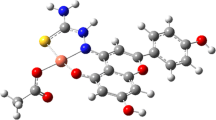Abstract
Stannous chloride (SnCl2) is a reducing chemical agent used in several man-made products. SnCl2 can generate reactive oxygen species (ROS); therefore, studies have been carried out in order to better understand its damaging action in biological systems. In this work, calf thymus DNA, triphosphate nucleotides and isolated bases were incubated with SnCl2 and the results were analyzed through UV spectrophotometry. The presence of stannous ions altered the absorption spectra of all three isolates. The amount of stannous ions associated to DNA was measured by atomic absorption spectrophotometry. Data showed that more than 40% of the initial SnCl2 concentration was present in the samples. Our results are in accordance with the damaging potential of this salt and present evidence that stannous ions can complex with DNA, inducing ROS in its vicinity, which may be responsible for the observed lesions. (Mol Cell Biochem xxx: 173–179, 2005)
Similar content being viewed by others
References
Kappus H, Sies H: Toxic drug effects associated with oxygen metabolism: redox cycling and lipid peroxidation. Experientia 37: 1233–1258, 1981
Ferguson LR: Antimutagens as cancer chemopreventive agents in the diet. Mutat Res 317: 395–410, 1994
Sies H: Oxidative stress. Academic Press, London, 1985
Imlay JA, Linn S: DNA damage and oxygen radical toxicity. Science 240: 1302–1309, 1988
Dantas FJS, Moraes MO, Carvalho EF, Valsa JO, Bernardo-Filho M, Caldeira-de-Araújo A: Lethality induced by stannous chloride on Escherichia coli AB1157: participation of reactive oxygen species. Food Chem Toxicol 34: 959–962, 1996
Valko M, Izakovic M, Mazur M, Rhodes CJ, Telser J: Role of oxygen radicals in DNA damage and cancer incidence. Mol Cell Biochem 266(1–2): 37–56, 2004
Costa M, Salnikow K, Sutherland JE, Broday L, Peng W, Zhang QW, Kluz T: The role of oxidative stress in nickel and chromate genotoxicity. Mol Cell Biochem 234(1): 265–275, 2002
De La Fuente H, Portales-Perez D, Baranda L, Diaz-Barriga F, Saavedra-Alanis V, Layseca E, Gonzalez-Amaro R: Effect of arsenic, cadmium and lead on the induction of apoptosis of normal human mononuclear cells. Clin Exp Immunol 129: (1) 69–77, 2002
Bal W, Kasprzak KS: Induction of oxidative DNA damage by carcinogenic metals. Toxicol Lett 127: 55–62, 2002
Milaeva E, Petrosyan V, Berberova N, Pimenov Y, Pellerito L: Organic derivatives of mercury and tin as promoters of membrane lipid peroxidation. Bioinorg Chem Appl 2(1–2): 69–91, 2004
Caldeira-de-Araújo A, Dantas FJS, Moraes MO, Felzenszwalb I, Bernardo-Filho M: Stannous chloride participates in the generation of reactive oxygen species. J Braz Assoc Adv Sci 48: 109–113, 1996
Dantas FJS, Moraes MO, De Mattos JCP, Bezerra RJAC, Carvalho EF, Bernardo-Filho M, Caldeira-de-Araújo A: Stannous chloride mediates single strand breaks in plasmid DNA through reactive oxygen species formation. Toxicol Lett 110: 129–136, 1999
De Mattos JCP, Dantas FJS, Bezerra RJAC, Bernardo-Filho M, Cabral-Neto JB, Lage C, Leitão AC, Caldeira-de-Araujo, A: Damage induced by stannous chloride in plasmid DNA. Toxicol Lett 116: 159–163, 2000
Cabral RE, Leitão AC, Lage C, Caldeira-de-Araújo A, Bernardo-Filho M, Dantas FJS, Cabral-Neto JB: Mutational potentiality of stannous chloride: an important reducing agent in the 99 mTc-radiopharmaceuticals. Mutat Res 408: 129–135, 1998
Dantas FJS, De Mattos JCP, Moraes MO, Viana ME, Lage C, Cabral-Neto JB, Leitão AC, Bernardo-Filho M, Bezerra RJAC, Carvalho JJ, Caldeira-de-Araújo A: Genotoxic effects of stannous chloride (SnCl2) in K562 cell line, Food Chem Toxicol 40: 1493–1498, 2002
Mello-Filho AC, Meneghini R: Iron is the intracellular metal involved in the production of DNA damage by oxygen radicals. Mutat Res 251: 109–113, 1991
Chen F, Ding M, Castranova V, Shi X: Carcinogenic metals and NF-kappaB activation. Mol Cell Biochem 222(1–2): 159–171, 2001
Author information
Authors and Affiliations
Corresponding author
Rights and permissions
About this article
Cite this article
de Mattos, J.C.P., Lage, C., Dantas, F.J.S. et al. Interaction of stannous chloride leads to alteration in DNA, triphosphate nucleotides and isolated bases. Mol Cell Biochem 280, 173–179 (2005). https://doi.org/10.1007/s11010-005-8908-6
Received:
Accepted:
Issue Date:
DOI: https://doi.org/10.1007/s11010-005-8908-6




